 W
WThis is an incomplete list of battles of the Second Punic War, showing the battles on the Italian peninsula and some in Africa, in Sicily and Hispania.218 BC Summer: Battle of Lilybaeum – A Roman fleet of 20 quinqueremes defeated a Carthaginian fleet of 35 galleys. Capture of Malta – Roman army under Tiberius Sempronius Longus conquers the Carthaginian-held island of Malta. August – Hannibal conquered Catalonia. September- Hannibal defeated the Gaul Volcae tribe in the Battle of Rhone Crossing. October: Hannibal's army defeated Gauls in two battles while crossing the Alps. November: Battle of the Ticinus – Hannibal defeated the Romans under Publius Cornelius Scipio the Elder in a small cavalry skirmish. December: Battle of the Trebia – Hannibal defeated the Romans under Tiberius Sempronius Longus, who had foolishly attacked. Late year: Battle of Cissa – Gnaeus Cornelius Scipio Calvus defeated Hanno. Iberia north of the Ebro River came under Roman control. 217 BC Spring: Battle of Ebro River – A Roman fleet, aided by ships from Massilia, surprised and defeated the Iberian contingent of the Carthaginian fleet. 21 June: Battle of Lake Trasimene – In an ambush, Hannibal destroyed the Roman army of Gaius Flaminius, who was killed. September: Battle of Ager Falernus – Hannibal was trapped by Quintus Fabius Maximus Verrucosus in Ager Falernus, but he managed to escape. Autumn: Battle of Geronium – Hannibal trapped and inflicted severe losses on a Roman army under Marcus Minucius Rufus. The timely intervention of the Dictator Quintus Fabius Maximus saved the Romans from another disaster. 216 BC August: Battle of Cannae – Hannibal destroyed the Roman army led by Lucius Aemilius Paullus and Gaius Terentius Varro in what is considered one of the great masterpieces of the tactical art. Late year: Battle of Silva Litana – The Gallic Boii wiped out a Roman army under Lucius Postumius Albinus. Late year: First Battle of Nola – Roman general Marcus Claudius Marcellus held off an attack by Hannibal. 215 BC Spring: Battle of Dertosa – Hasdrubal Barca is defeated by the Scipio brothers. The Romans raided Carthaginian territory south of the Ebro river. August: Second Battle of Nola – Marcellus again repulsed an attack by Hannibal. Late year: Battle of Decimomannu – A Carthaginian expedition under Hasdrubal the Bald is defeated near Caralis in Sardinia. A Roman fleet under Titus Otacilius Crassus defeated a Carthaginian fleet near Sardinia. 214 BC Third Battle of Nola – Marcellus fought an inconclusive battle with Hannibal. Battle of Beneventum – Tiberius Sempronius Gracchus's slave legions defeat Hanno and, therefore, deny Hannibal his reinforcements. 213 BC The Siege of Syracuse begins. 212 BC March: Battle of Tarentum – Hannibal, after careful planning and collaboration from the Greek populace, takes the city of Tarentum in a daring night raid. The Romans continue to hold the Citadel at the mouth of the port. May: Battle of Beneventum – Quintus Fulvius Flaccus defeats Hanno. First Battle of Capua – Hannibal defeated the consuls Q. Fulvius Flaccus and Appius Claudius, but the Roman army escaped. Siege of Capua temporarily lifted. Battle of the Silarus – Hannibal destroyed the army of the Roman praetor M. Centenius Penula in Campania. First Battle of Herdonia – Hannibal destroyed the Roman army of the praetor Gnaeus Fulvius in Apulia. The Siege of Syracuse ends with the fall of the city. Archimedes is accidentally slain. 211 BC Battle of the Upper Baetis – Publius Cornelius Scipio and Gnaeus Cornelius Scipio Calvus were killed in battle with Hasdrubal Barca. Siege of Capua – The Romans besiege and capture the city. 210 BC Second Battle of Herdonia – Hannibal destroyed the Roman army of Fulvius Centumalus, who was killed. Battle of Numistro – Hannibal fights Marcellus once more. Battle of Sapriportis – The Tarentine Greek navy defeated a Roman squadron trying to reinforce the Citadel. 209 BC January/February: Battle of Cartagena – P. Cornelius Scipio the Younger captured Cartagena, the main Carthaginian base in Hispania. Spring: Battle of Canusium – Hannibal once again confronted Marcellus in an indecisive battle. Marcellus was recalled to Rome on charges of bad leadership. Assault on Tarentum – Romans under Quintus Fabius Maximus reconquer Tarentum. 208 BC Spring: Battle of Baecula – Romans in Hispania under P. Cornelius Scipio the Younger defeated Hasdrubal Barca. Hasdrubal managed to save 2/3 of his army, treasures and elephants and retreat. Summer: Battle of Petelia – Hannibal ambushes and destroys a small Roman force Battle of Clupea – The Carthaginian navy is defeated in a battle off the African coast. 207 BC Spring: Battle of Grumentum – Roman general Gaius Claudius Nero fought an indecisive battle with Hannibal, then marched north to confront Hasdrubal Barca, who had invaded Italy. 23 June: Battle of the Metaurus – Hasdrubal Barca was defeated and killed by Livius and Nero's combined Roman army. Is thought by many as one of the most decisive battles in history. Naval Battle of Utica – A Carthaginian fleet of 70 ships is defeated by a Roman fleet of 100 ships near Utica. 206 BC Spring: Battle of Ilipa – Scipio destroyed a large Carthaginian army in Hispania. Mutiny at Sucro – Scipio quells a mutiny in Hispania Battle of Carteia – Romans defeat Carthaginians in Hispania 204 BC Autumn: Siege of Utica – Scipio's siege of Utica in Africa fails. Battle of Crotona – Hannibal fought a drawn battle against the Roman general Sempronius in Southern Italy. 203 BC Battle of Insubria – Romans defeat Carthaginians under Mago Barca in northern Italy. Battle of Utica – Scipio attacks and destroys a Carthaginian-Numidian army. Battle of the Great Plains – Romans under Scipio defeated the Carthaginian army of Hasdrubal Gisco and Syphax. Hannibal was recalled to Africa. Battle of Cirta – Masinissa and the Romans defeat and capture Syphax. Battle of Castra Cornelia – Carthaginian fleet under Hasdrubal plunders the Roman supply convoy sailing to resupply Scipio's army in Africa near Utica. 202 BC 19 October: Battle of Zama – Scipio Africanus Major decisively defeated Hannibal in North Africa, ending the Second Punic War.
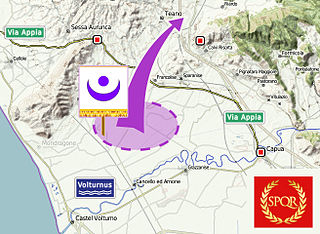 W
WThe Battle of Ager Falernus was a skirmish during the Second Punic War between the armies of Rome and Carthage. After winning the Battle of Lake Trasimene in Italy in 217 BC, the army commanded by Hannibal marched south and reached Campania. The Carthaginians ultimately moved into the district of Falernum, a fertile river valley surrounded by mountains.
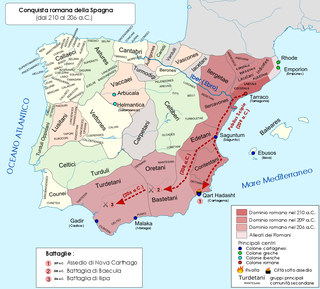 W
WThe Battle of Baecula was a major field battle in Iberia during the Second Punic War. Roman Republican and Iberian auxiliary forces under the command of Scipio Africanus routed the Carthaginian army of Hasdrubal Barca.
 W
WThe Battle of Beneventum was fought in 214 BC near modern Benevento during the Second Punic War. Roman legions under Tiberius Sempronius Gracchus defeated Hanno's Carthaginian forces, denying Hannibal reinforcements. Livy gives a brief description of the battle, which was part of the Roman campaign to subdue the southern Italian city-states that had joined Hannibal after the Battle of Cannae.
 W
WThe Battle of Beneventum was fought between Carthage and Roman republic in 212 BC. During this conflict Hanno, son of Bomilcar was defeated by Quintus Fulvius Flaccus. Livy gives a short account of this battle at 25.13-14.
 W
WThe Battle of Cannae was a key engagement of the Second Punic War between the Roman Republic and Carthage, fought on 2 August 216 BC near the ancient village of Cannae in Apulia, southeast Italy. The Carthaginians and their allies, led by Hannibal, surrounded and practically annihilated a larger Roman and Italian army under the consuls Lucius Aemilius Paullus and Gaius Terentius Varro. It is regarded as one of the greatest tactical feats in military history and one of the worst defeats in Roman history.
 W
WThe Battle of Canusium also known as the Battle of Asculum was a three-day engagement between the forces of Rome and Carthage. It took place in Apulia during the spring of 209 BC, the tenth year of the Second Punic War. A larger Roman offensive, of which it was a part, aimed to subjugate and to punish cities and tribes that had abandoned the alliance with Rome after the Battle of Cannae, and to narrow the base of the Carthaginian leader, Hannibal, in southern Italy.
 W
WThe siege of Capua was fought in 211 BC, when the Romans besieged Capua. It is described by Polybius at 9.4-7, by Livy at 26.4-6, and by Appian at 37-44 of his Hannibalic War.
 W
WThe First Battle of Capua was fought in 212 BC between Hannibal and two Roman consular armies. The Roman force was led by two consuls, Quintus Fulvius Flaccus and Appius Claudius Pulcher. The Roman force was defeated, but managed to escape. Hannibal temporarily managed to raise the siege of Capua. A tactical Carthaginian victory, it ultimately did not help the Capuans.
 W
WOne of Scipio's first major battles in Spain, this siege is described by Appian in his Iberica at 5.25-28. Now this Hasdrubal ordered all the remaining Carthaginian forces in Spain to be collected at the city of Carmone to fight Scipio with their united strength. Hither came a great number of Spaniards under the lead of Mago, and of Numidians under Masinissa. Hasdrubal had the infantry in a fortified camp, Masinissa and Mago, who commanded the cavalry, bivouacking in front of it. Scipio divided his own horse so that Lælius should attack Mago while he himself should be opposed to Masinissa. This fight was for some time doubtful and severe to Scipio, since the Numidians discharged their darts at his men, then suddenly retreated, and then wheeled and returned to the charge. But when Scipio ordered his men to hurl their javelins and then pursue without intermission, the Numidians, having no chance to turn around, retreated to their camp. Here Scipio desisted from the pursuit and encamped in a strong position, which he had chosen, about ten stades from the enemy. The total strength of the enemy was 70,000-foot, 5000 horse, and thirty-six elephants. That of Scipio was not one-third of the number. For some time, therefore, he hesitated and did not venture a fight, except some light skirmishes. [26] When his supplies began to fail and hunger attacked his army, Scipio considered that it would be base to retreat. Accordingly he sacrificed, and bringing the soldiers to an audience immediately after the sacrifice, and putting on again the look and aspect of one inspired, he said that the deity had appeared to him in the customary way and told him to attack the enemy, and had assured him that it was better to trust in heaven than in the size of his army because his former victories were gained by divine favor rather than by numerical strength. In order to inspire confidence in his words he commanded the priests to bring the entrails into the assembly. While he was speaking he saw some birds flying overhead with great swiftness and clamor. Looking up he pointed them out and exclaimed this was a sign of victory which the gods had sent him. He followed their movement, gazing at them and crying out like one possessed. The whole army, as it saw him turning hither and thither, imitated his actions, and all were fired with the idea of certain victory. When he had everything as he wished he did not hesitate, nor permit their ardor to cool, but still as one inspired exclaimed: "These signs tell us that we must fight at once." When they had taken their food he ordered them to arm themselves, and led them against the enemy, who were not expecting them, giving the command of the horse to Silanus and of the foot to Lælius and Marcius. [27] Hasdrubal, Mago, and Masinissa, when Scipio was coming upon them unawares, being only ten stades distant, and their soldiers not having taken their food, drew up their forces in haste, amid confusion and tumult. Battle being joined with both cavalry and infantry, the Roman horse prevailed over the enemy by the same tactics as before, by giving no respite to the Numidians, thus making their darts of no effect by reason of their nearness. The infantry were severely pressed by the great numbers of the Africans and were worsted by them all day long, nor could Scipio stem the tide of battle, although he was everywhere cheering them on. Finally, giving his horse in charge of a boy, and snatching a shield from a soldier, he dashed alone into the space between the two armies, shouting: "Romans, rescue your Scipio in his peril."3 Then those who were near seeing, and those who were distant hearing, what danger he was in, and all being in like manner moved by a sense of shame and fear for their general's safety, charged furiously upon the enemy, uttering loud cries. The Africans were unable to resist this charge. They gave way, as their strength was failing for lack of food, of which they had had none all day. Then, for a short space of time, there was a terrific slaughter. Such was the result to Scipio of the battle of Carmone, although it had been for a long time doubtful. The Roman loss was 800; that of the enemy 15,000. [28] After this engagement the enemy retreated with all speed, and Scipio followed dealing blows and doing damage whenever he could overtake them. After they had occupied a stronghold, where there was plenty of food and water, and where nothing could be done but lay siege to them, Scipio was called away on other business. He left Silanus to carry on the siege while he went into other parts of Spain and subdued them. The Africans who were besieged by Silanus deserted their position and retreated again until they came to the straits and passed on to Gades. Silanus, having done them all the harm he could, rejoined Scipio at New Carthage. In the meantime Hasdrubal, the son of Hamilcar, who was still collecting troops along the Northern ocean, was called by his brother Hannibal to march in all haste to Italy. In order to deceive Scipio he moved along the northern coast, and passed over the Pyrenees into Gaul with the Celtiberian mercenaries whom he had enlisted. In this way he was hastening into Italy without the knowledge of the Italians. (the creator of this stub was too lazy/busy to make this a full article, help Wikipedia and expand the article based on the above text!)
 W
WThe Battle of Cartagena in 209 BC was a successful Roman assault on the Carthaginian stronghold New Carthage (Cartagena) in Iberia that took place in late January to early February of 209 BC.
 W
WThe Battle of Cissa was part of the Second Punic War. It was fought in the fall of 218 BC, near the Celtic town of Tarraco in north-eastern Iberia. A Roman army under Gnaeus Cornelius Scipio Calvus defeated an outnumbered Carthaginian army under Hanno, thus gaining control of the territory north of the Ebro River that Hannibal had just subdued a few months prior in the summer of 218 BC. This was the first battle that the Romans had ever fought in Iberia. It allowed the Romans to establish a secure base among friendly Iberian tribes and due to the eventual success of the Scipio brothers in Spain, Hannibal looked for but never received reinforcements from Spain during the war,
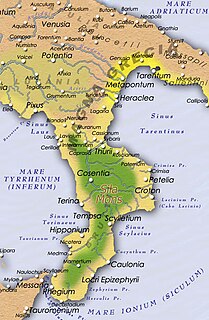 W
WThe battle or, more precisely, the battles of Croton in 204 and 203 BC were, as well as the raid in Cisalpine Gaul, the last larger scale engagements between the Romans and the Carthaginians in Italy during the Second Punic War. After Hannibal’s retreat to Bruttium due to the Metaurus debacle, the Romans continuously tried to block his forces from gaining access to the Ionian Sea and cut his eventual escape to Carthage by capturing Croton. The Carthaginian commander struggled to retain his hold on the last efficient port which had remained in his hands after years of fighting and was ultimately successful.
 W
WThe Battle of Ibera, also known as the Battle of Dertosa, was fought in the spring of 215 BC on the south bank of the Ebro River near the town of Ibera and was part of the Second Punic War. A Roman army, under the command of the brothers Gnaeus and Publius Scipio, defeated a similarly sized Carthaginian army under Hasdrubal Barca. The Romans, under Gnaeus Scipio, had invaded Iberia in late 218 BC and established a foothold after winning the Battle of Cissa. This lodgement, on the north-east Iberian coast, between the Ebro and the Pyrenees, blocked the route of any reinforcements from Iberia for the army of Hannibal, who had invaded Italy from Iberia earlier in the year. Hasdrubal attempted to evict the Romans in 217 BC, but this ended in defeat when the Carthaginian naval contingent was mauled at the Battle of Ebro River.
 W
WThe Battle of Geronium or Gerunium took place during the Second Punic War, where a large skirmish and battle took place in the summer and autumn of 217 BC respectively.
 W
WThe Battle of the Great Plains, also known as the Battle of the Bagrades, was a battle fought between Scipio Africanus of Rome and a combined Carthaginian and Numidian army late in the Second Punic War. It occurred on the plains south of Bulla Regia around the upper Bagradas River. The attack was designed as a diversionary tactic by Rome to disrupt Hannibal's attack on Italy. By defeating the Carthaginians, Scipio Africanus caused Hannibal to leave Italy and return to Africa, where he was later defeated at Zama.
 W
WThe Battle of Grumentum was fought in 207 BC between Romans led by Gaius Claudius Nero, and a part of Hannibal's Carthaginian army. The battle was a minor Roman victory, and Nero marched north where he defeated and killed Hannibal's brother Hasdrubal at Metaurus. The battle is described by Livy at 27.41-42.
 W
WThe Battle of Carteia, also known by the modern name Battle of the Guadalquivir, was a battle of the Second Punic War that took place in 206 BC between the forces of Carthage and the Roman Republic. The name "Battle of the Guadalquivir" is anachronistic, since the river's name "el Guadalquivir", from the Arabic al-wadi al-kabir, was not used until the Islamic conquest of Spain over nine hundred years after the battle. The Carthaginian forces were commanded by Hanno and the Romans by Gaius Lucius Marcius Septimus. The battle resulted in a Roman victory.
 W
WThe second battle of Herdonia took place in 210 BC during the Second Punic War. Hannibal, leader of the Carthaginians, who had invaded Italy eight years earlier, encircled and destroyed a Roman army which was operating against his allies in Apulia. The heavy defeat increased the war's burden on Rome and, piled on previous military disasters, aggravated the relations with her exhausted Italian allies. For Hannibal the battle was a tactical success, but did not halt for long the Roman advance. Within the next three years the Romans reconquered most of the territories and cities lost at the beginning of the war and pushed the Carthaginian general to the southwestern end of the Apennine peninsula. The battle was the last Carthaginian victory of the war; all battles which followed were either inconclusive or Roman victories.
 W
WThe first Battle of Herdonia was fought in 212 BC during the Second Punic War between Hannibal's Carthaginian army and Roman forces led by Praetor Gnaeus Fulvius Flaccus, brother of the consul. The Roman army was destroyed, leaving Apulia free of Romans for the year.
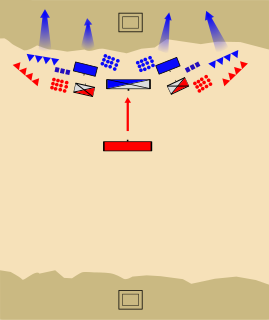 W
WThe Battle of Ilipa was an engagement considered by many as Scipio Africanus’s most brilliant victory in his military career during the Second Punic War in 206 BC.
 W
WThe capture of Malta was the successful invasion of the Carthaginian island of Malta by forces of the Roman Republic led by Tiberius Sempronius Longus in the early stages of the Second Punic War in 218 BC.
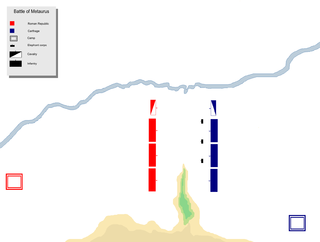 W
WThe Battle of the Metaurus was a pivotal battle in the Second Punic War between Rome and Carthage, fought in 207 BC near the Metauro River in Italy. The Carthaginians were led by Hasdrubal Barca, brother of Hannibal, who was to have brought siege equipment and reinforcements for Hannibal. The Roman armies were led by the consuls Marcus Livius, who was later nicknamed the Salinator, and Gaius Claudius Nero.
 W
WThe Roman army's mutiny at Sucro, a no longer existing ancient fort in Spain, took place in early 206 BC, during the Roman conquest of Hispania in the Second Punic War against Carthage. The mutineers had several grievances, including not having received the pay due to them and being under-supplied. The proximate causes of the mutiny had existed for years, but had not been addressed to the soldiers' satisfaction. Matters came to a head after rumors spread that their commanding general, Scipio Africanus, had become gravely ill. But the stories proved to be without foundation; he succeeded in suppressing the mutiny and executed its ringleaders.
 W
WThe Third Battle of Nola was fought in 214 BC between Hannibal and a Roman army led by Marcus Claudius Marcellus. It was Hannibal's third attempt to take the town of Nola. Once again, Marcellus successfully prevented the town's capture.
 W
WThe Second Battle of Nola was fought in 215 BC between Hannibal's army and a Roman Army under Marcus Claudius Marcellus. It was Hannibal's second attempt to seize Nola after a failure the year before. He was again repelled and would make one more, also unsuccessful attempt the next year.
 W
WThe First Battle of Nola was fought in 216 BC between the forces of Hannibal and a Roman force led by Marcus Claudius Marcellus. Hannibal was attempting to seize the town of Nola: He failed to do so, and would make two more unsuccessful attempts on the city over the next two years.
 W
WThe Battle of Numistro was fought in 210 BC between Hannibal's army and one of the Roman consular armies led by consul Marcus Claudius Marcellus. It was the fourth time they met in a battle. Previous encounters were located around the walls of Nola (Campania) in 216, 215, and 214 and had been favourable for the Roman side.
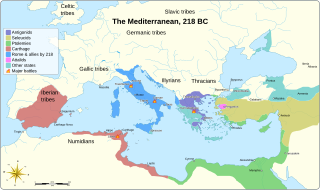 W
WThe Battle of Insubria in 203 BC was the culmination of a major war, carried out by the Carthaginian commander Mago, son of Hamilcar Barca, at the end of the Second Punic war between Rome and Carthage in what is now northwestern Italy. Mago had landed at Genoa, Liguria, two years before, in an effort to keep the Romans busy to the North and thus hamper indirectly their plans to invade Carthage's hinterland in Africa. He was quite successful in reigniting the unrest among various peoples against the Roman dominance. Rome was forced to concentrate large forces against him which finally resulted in a battle fought in the land of the Insubres (Lombardy). Mago suffered defeat and had to retreat. The strategy to divert the enemy's forces failed as the Roman general Publius Cornelius Scipio laid waste to Africa and wiped out the Carthaginian armies that were sent to destroy the invader. To counter Scipio, the Carthaginian government recalled Mago from Italy. However, the remnants of the Carthaginian forces in Cisalpine Gaul continued to harass the Romans for several years after the end of the war.
 W
WThe Battle of the Rhône Crossing was fought in autumn of 218 BC during Hannibal's approach to the Italian Alps, when an army of the Gallic Volcae tribe attacked the Carthaginian army on the east bank of the Rhone. Acting on behalf of a Roman army camped near Massalia, the Volcae intended to prevent the Carthaginians from crossing the Alps and invading Italy. Before crossing the river, the Carthaginians sent a detachment upriver under Hanno, son of Bomilcar, to cross at a different point and take position behind the Gauls. Once the detachment was in place, Hannibal began to cross the river with the main contingent of the army. As the Gauls massed to oppose Hannibal's force, Hanno attacked from behind, leading to a route of the Volcae army. This battle was Hannibal's first major battle and victory outside of the Iberian Peninsula and gave him an unopposed path to the Alps and into Italy.
 W
WThe siege of Saguntum was a battle which took place in 219 BC between the Carthaginians and the Saguntines at the town of Saguntum, near the modern town of Sagunto in the province of Valencia, Spain. The battle is mainly remembered today because it triggered one of the most important wars of antiquity, the Second Punic War.
 W
WThe Battle of the Silarus was fought in 212 BC between Hannibal's army and a Roman force led by centurion Marcus Centenius Penula. The Carthaginians were victorious, destroying the entire Roman army and killing 15,000 Roman soldiers in the process.
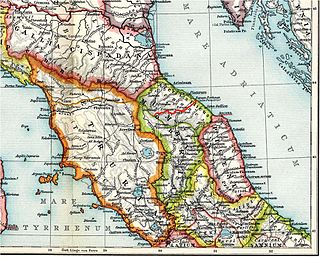 W
WThe Battle of Silva Litana was an ambush during the Second Punic War that took place in a forest 75 miles northwest of the Roman city of Ariminum in 216 BC. The Gallic Boii surprised and destroyed a Roman army of 25,000 men under the consul-elect Lucius Postumius Albinus. Only ten men escaped the ambush, few prisoners were taken and Postumius was killed, decapitated and his skull covered with gold by the Boii. News of the military disaster, coming either several days or months after the defeat at Cannae, triggered a renewed panic in Rome and the Romans postponed military operations against the Gauls until the conclusion of the Second Punic War.
 W
WThe siege of Syracuse by the Roman Republic took place in 213–212 BC. The Romans successfully stormed the Hellenistic city of Syracuse after a protracted siege, giving them control of the entire island of Sicily. During the siege, the city was protected by weapons developed by Archimedes. Archimedes, the great inventor and polymath, was slain at the conclusion of the siege by a Roman soldier, in contravention of the Roman proconsul Marcellus' instructions to spare his life.
 W
WThe Battle of Tarentum of 209 BC was a battle in the Second Punic War. The Romans, led by Quintus Fabius Maximus Verrucosus, recaptured the city of Tarentum that had betrayed them in the first Battle of Tarentum in 212 BC. This time the commander of the city, Carthalo, turned against the Carthaginians, and supported the Romans.
 W
WThe Battle of Tarentum in March 212 BC was a military engagement in the Second Punic War.
 W
WThe Battle of Ticinus was a battle of the Second Punic War fought between the Carthaginian forces of Hannibal and the Romans under Publius Cornelius Scipio in late November 218 BC. The battle took place in the flat country on the right bank of the River Ticinus, to the west of modern Pavia in northern Italy. Hannibal led 6,000 African and Iberian cavalry, while Scipio led 3,600 Roman, Italian and Gallic cavalry and a large but unknown number of light infantry javelinmen.
 W
WThe Battle of Lake Trasimene was fought when a Carthaginian force under Hannibal ambushed a Roman army commanded by Gaius Flaminius on 21 June 217 BC, during the Second Punic War. It took place on the north shore of Lake Trasimene, to the east of Cortona, and resulted in a heavy defeat for the Romans.
 W
WThe Battle of the Trebia was the first major battle of the Second Punic War, fought between the Carthaginian forces of Hannibal and a Roman army under Sempronius Longus on 22 or 23 December 218 BC. It took place on the flood plain of the west bank of the lower Trebia River, not far from the settlement of Placentia, and resulted in a heavy defeat for the Romans.
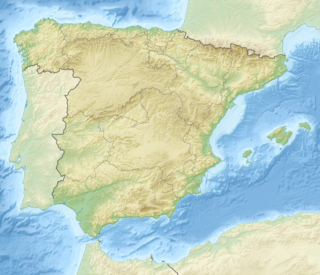 W
WThe Battle of the Upper Baetis was a double battle, comprising the battles of Castulo and Ilorca, fought in 211 BC during the Second Punic War between a Carthaginian force led by Hasdrubal Barca and a Roman force led by Publius Cornelius Scipio and his brother Gnaeus. The immediate result was a Carthaginian victory in which both Roman brothers were killed. Before this defeat, the brothers had spent seven years campaigning in Hispania, which had limited the resources available to Hannibal, who was simultaneously fighting the Romans in Italy.
 W
WThe siege of Utica was a siege during the Second Punic War between the Roman Republic and Carthage in 204 BC. Roman general Scipio Africanus besieged Utica, attempting to use it as a supply base for his campaign against Carthage in North Africa. He launched repeated and coordinated army-navy assaults on the city, all of which failed. The arrival of a large Carthaginian and Numidian relief army under Carthaginian general Hasdrubal Gisco and Numidian king Syphax in late autumn forced Scipio to break off the siege after 40 days and retreat to the coast.
 W
WThe Battle of Utica was fought in 203 BC between armies of Rome and Carthage during the Second Punic War. Through a surprise attack, the Roman commander Scipio Africanus managed to destroy a numerous force of Carthaginians and their Numidian allies not far from the outflow of the Medjerda River in modern Tunisia. Thus he gained a decisive strategic advantage, switched the focus of the war from Italy and Iberia to Carthaginian north Africa, and contributed largely to the final Roman victory.
 W
WThe Battle of Zama was fought in 202 BC near Zama, now in Tunisia, and marked the end of the Second Punic War. A Roman army led by Publius Cornelius Scipio, with crucial support from Numidian leader Masinissa, defeated the Carthaginian army led by Hannibal.